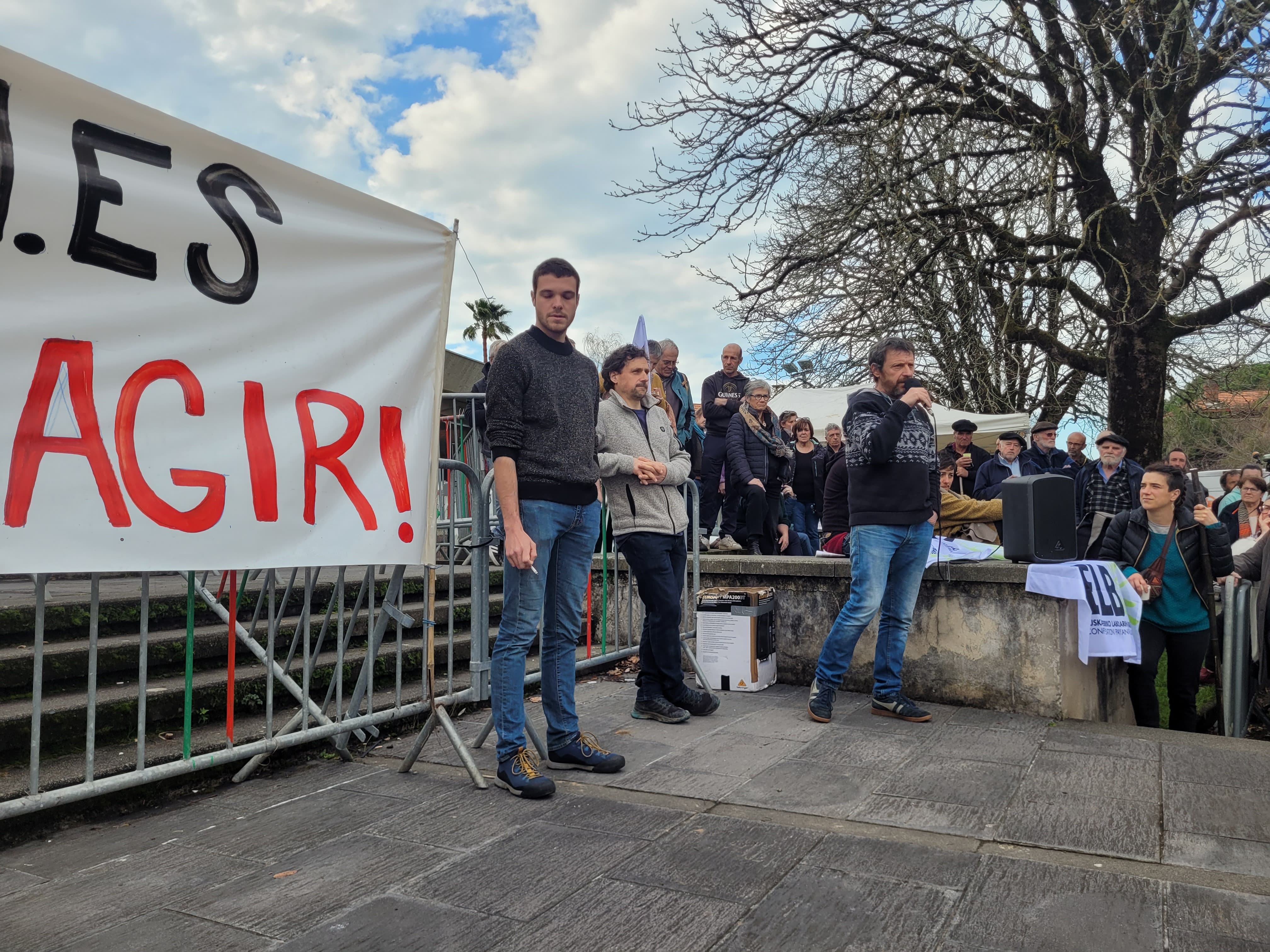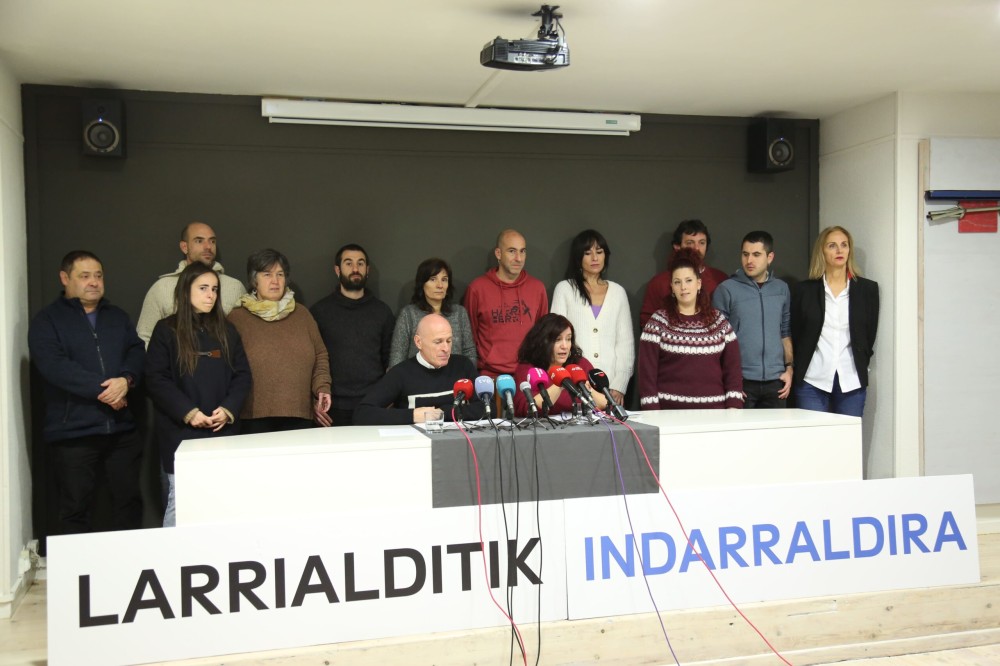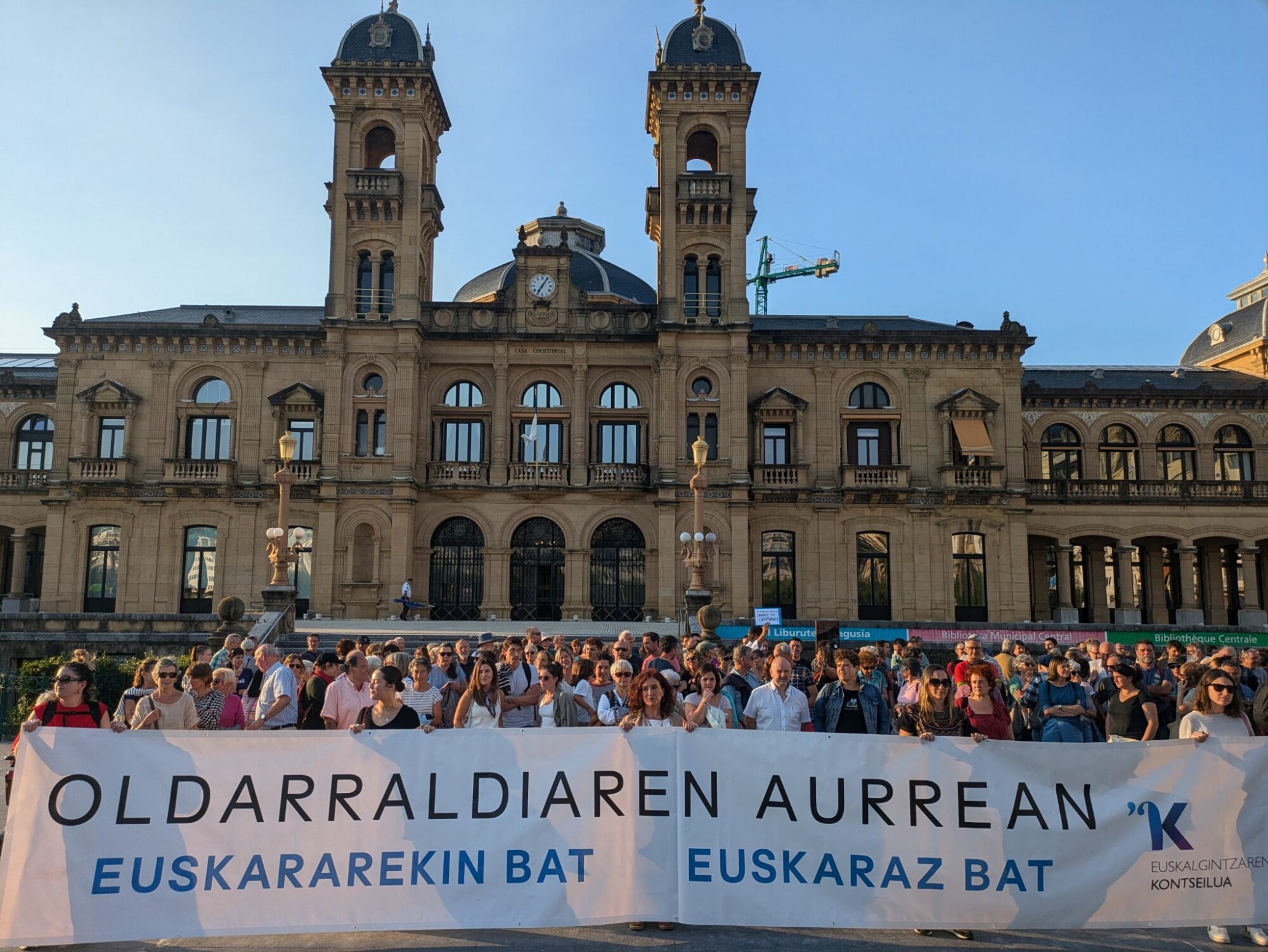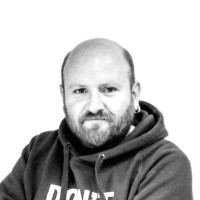Without corners, a huge void for the Basque culture of Pamplona
- This year the cultural center El Rincón de los Gigantes celebrates its fifteenth anniversary. The fifth and, apparently, the last. Over the last ten years, it has become the main venue for programming in Basque language and culture organized by the City Council of Pamplona. With the disappearance of this meeting point for many Basques and Basques, it is suspected that Basque events will be scattered throughout the city in eleven halls.
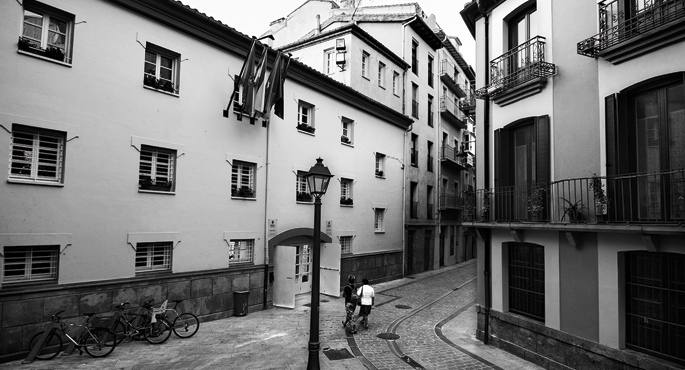
In May 1996, the cultural center known today as the Rincón de los Gigantes (Corner of the Giants) opened. The students of the Municipal School Workshop renovated the former convent of the Carmelites Barefoot, located in Descalzos Street in the Old Town of Pamplona, while it was not yet clear what it would be used for. Valentín Redín, well-known director and author of theatre, and then Director of Culture of the City Council, would be the one who would decide the future of the new place to a large extent. In addition to moving the Cultural Area of the City Council to its new offices, it prepared a large courtyard covered with mobile closures to house the Giants and Cabezas of the Pamplona City Council. That's where the name came from. Those who have never arrived, however, have been cardboard giants, as they have always had the bus stop as a hideout: The old station until 2007, and since then, new. However, I cannot say that this place has no large neighbours: Two large stone hercules that were removed from the Town Hall’s mansion were placed in the corner for decorative purposes four years ago.
Use of
During the first years, with the mayor of the CDN, Javier Chorraut, and the socialist councilor for culture, Joaquín Pascal, the hall was open to citizen initiatives. Anyone could have organized activities there. In 1999, however, when Yolanda Barcina came to the post of mayor on behalf of the UPN, this road was cut short. From then on, only the programs organized by the City Council itself would have a place in this room. Thus, and little by little, the cultural activities conducted by the Basque Service were gaining ground both on the patio stage and in the conference room on the first floor.
In 2009 the new use was approved: the City Council decided to hold the last civil goodbye sessions there, but during this time it has only been used twice for this task. One of them was the farewell ceremony of the writer Pablo Antoñana.
Enlargement of the Museum of Navarre
The main reason for the possible disappearance of the Rincón de los Gigantes must be found at the other end of Descalzos Street. The expansion project of the Museum of Navarre, located there, is underway. Last year the Government of Navarre and the City Council of Pamplona signed a protocol for the opening of the new Contemporary Art Room in this museum. This is how the General Plan for the Promotion and Development of Contemporary Art, presented to Parliament two years ago by the Minister of Culture, Juan Ramón Corpas, will begin to materialize. This plan proposes the construction of a new building of 5,000 square meters and three floors next to the current museum.
Mercedes Jover, the new director of the Museum of Navarre, explains that they are still reflecting on this subject, but “it will be a great opportunity to show the most important works of contemporary art that the museum has”. The director considers the project very appropriate because the location is perfect, in the heart of Pamplona.
The frequent criticism of the Museum of Navarre about Contemporary Art is that temporary exhibitions are scarce and that the permanent collection only includes works by deceased artists. The director, Mercedes Jover, clarifies that this criterion was approved several years ago “precisely because of the lack of space”.
Many doubts and concerns have been raised by society and especially by artists about Contemporary Art for a long time. Iñaki Arzoz, artist and researcher, says that in Navarre we are “twenty years behind”. He is also cautious about the new planning: “Here we talk about forming a network of rooms for Contemporary Art, but we lack nodes to connect.”
According to the diagnosis made last August by the Art Platform formed by many artists and groups, the lack of structure in Navarre is evident. In the private sphere, in 2009, six galleries disappeared, among them the oldest, Pintzel, and the youngest, Reciclarte. Currently, only one remains working in this field of art: By Moisés Pérez de Albéniz. In the public sphere, there is no space of its own for Contemporary Art and there is a predominance of discoordination.
These artists point out that the initiatives carried out in the cultural centers are mainly based on the work of their creators and that the contemporary art exhibitions in the municipal halls tend to have to alternate with the “informative” ones. On the other hand, the Oteiza Museum, an important space that could have been a pioneer, has been limited to the work and period of Jorge Oteiza; and the new Contemporary Art Center of the Island is empty. This center has now recently come into the hands of the Government of Navarre because the Island Council could not manage it. In a few years it has undergone numerous and profound changes and is now in the moment of redefinition, waiting for a new director. In the same island of Pamplona there is also the museum of the Buldain Foundation, also working on its own.
The Museum of Navarre is not, however, the only new space associated with this type of art that is currently underway. The University of Navarre in Opus is about to open its museum, which will house the collection of art donated to them by the wealthy Huarte family.
Change of place of the Children's School
According to the planned project, to be able to build a new building next to the Museum it is necessary to change the location of the children's school that is located there. The Nuestra Señora de los Ángeles children’s school, owned by the Government of Navarra, is the only one located in the Old Town.
Turning today’s playground into a school for toddlers doesn’t seem like an easy task, at least in plain sight.
Alfredo Hoyuelos, a professor at the University of Navarre and member of the Navarre platform for Education 0-3, stressed that the law is clear and specific technical requirements must be met when organizing children’s schools. He also stressed that more public schools for children were needed. “Public and managed,” he says. The presence of the Basque language should also be clearly increased. There are currently thirteen municipal public children ' s schools in the city with 1,111 students in this academic year, and another five under the Department of Social Welfare of the Government of Navarre with 332 students. Three of them, the most recent ones, offer the Spanish-English model and only two offer teaching in Basque. These two are also located in the same neighborhood, El Chávea. A huge imbalance on all sides. The language model of the school that will be located in the Rincón de los Gigantes has not been known so far, but in recent years the commitment of the City Council to the English language is evident.
The future?
In winter in the shelter, at the top of the stoves, and in summer, with the opening of the mules above, under the stars, the lectures, singing and theater sessions that we have been able to enjoy in the Rincón de los Gigantes during this last decade are aunitz (see the chart on this page). The Basque Section of the City Council has organized several initiatives in which other entities have participated, such as the Ateneo de Navarra or the Amigos de Bertsolaris association.
I don't know what's going to happen to these programs from now on. In the network of spaces called Civivox that the City Council is expanding in the different neighborhoods of the city, the Basque language is totally excluded, as Iñaki Azkona, the Basque language technician of the City Council, has denounced on several occasions. Will these cultural routes, which have been slowly taking shape for years, be eliminated without a physical residence?
The last Domino tab to fall in this row will apparently be the programming around the Basque language.
Atzera begira jarrita, zalantza sortzen da, Descalzos kaleko eraikina azkenean ez ote den benetan erabili erraldoiei ostatu emateko. Hona hemen, urteek utzitako kultur uzta oparoa.
Jardunaldi eta zikloak: “Behe Nafarroara hurbilpen saioa kulturaren bidetik”, “Euskara euskaroen garaian”, “Euskara eta hizkuntza erromantzeak”, “Arteaz gozatu eta ulertzeko”, “Euskal literatura”, “Iruñea historian zehar”, “Done Jakue Bidea Nafarroan”, “Lauaxeta, jaiotzatik 100 urte”, “Kixote, 400 urte”, “Pío Baroja: 50 urte”, “Alexander Tapia Perurenari buruzko zikloa”, “Joan Perez de Lazarragari buruzko zikloa”, “Humboldt, Menendez Pidal eta Arturo Campionen inguruan: ernazimendua eta nazio identitate berrien sorrera”.
Hitzaldiak: Kepa Altonaga, Antton Luku, Jose Angel Irigaray, Koldo Izagirre, Castillo Suarez, Pello Salaburu, Jokin Muñoz, Jon Maia, Txomin Peillen, Joxemiel Bidador, Aingeru Epaltza, Roldan Jimeno, Anjel Lertxundi, Kirmen Uribe, Mª Jose Olaziregi, Bixente Serrano Izko, Caroline Phillips, Andoni Egaña, Jose Ignazio Ansorena, Iñaki Perurena, Miguel Ángel Lotina, José Mª Satrustegi, Juan San Martin, Maialen Lujanbio.
Musikariak: Ruper Ordorika, Pier Paul Berzaitz, Rafa Rueda, Maddi Oihenart, Petti, Josetxo Goia-Aribe, Jabier Muguruza, Mikel Markez, Kerobia, Joseba Irazoki, Karidadeko Benta, Maialen Errotabehere, Antton Valverde…
Irailaren 9ra gibelatu dute Kanboko kontseiluan gertatu kalapiten harira, hiru auzipetuen epaiketa. 2024eko apirilean Kanboko kontseilu denboran Marienia ez hunki kolektiboko kideek burutu zuten ekintzan, Christian Devèze auzapeza erori zen bultzada batean. Hautetsien... [+]
Oinarrizko maia komunitateko U Yich Lu’um [Lurraren fruitu] organizazioko kide da, eta hizkuntza biziberritzea helburu duen Yúnyum erakundekoa. Bestalde, antropologoa da, hezkuntza prozesuen bideratzaile, eta emakumearen eskubideen aldeko aktibista eta militante... [+]
The argument of a syllogism has three propositions, the last of which is necessarily deduced from the other two. It is with this deductive logic that I can analyze, for me, the long and traumatic socioecological conflict in Carpinteria that is taking place in Navarre.
The... [+]
Poloniar ikerlari talde batek Sevillako Italica aztarnategiko Txorien Etxea aztertu du, eta eraikinaren zoruko mosaikoak erromatar garaiko hegazti-bilduma xeheena dela ondorioztatu du.
Txorien etxean 33 hegazti daude mosaikoetan xehetasun handiz irudikatuta. Beste... [+]
I have recently worked in class on Etxahun Barkox’s beautiful and touching cobla. The bad guy! The afflictions of the house began because of the creation of the “praube with beauty”, but in seventeen years she had entered the sea of misfortune, having to abandon the girl... [+]
We have renewed the dialogue in the secretariat of the faculty, for the most auspicious: they are far away, for their enrollment, the times when only the students came. The trend has changed for a long time, and parents – most notably mothers – are taking an increasingly... [+]
Gure lurraldeetan eta bizitzetan sortzen diren behar, desio eta ekimenen inguruan gero eta gehiago entzuten dugu harreman eta proiektu publiko-komunitarioak landu beharraz, eta pozgarria da benetan, merkaturik gabeko gizarte antolaketarako ezinbesteko eredua baita. Baina... [+]









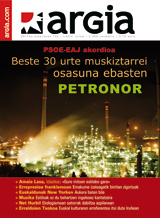


_2.jpg)



